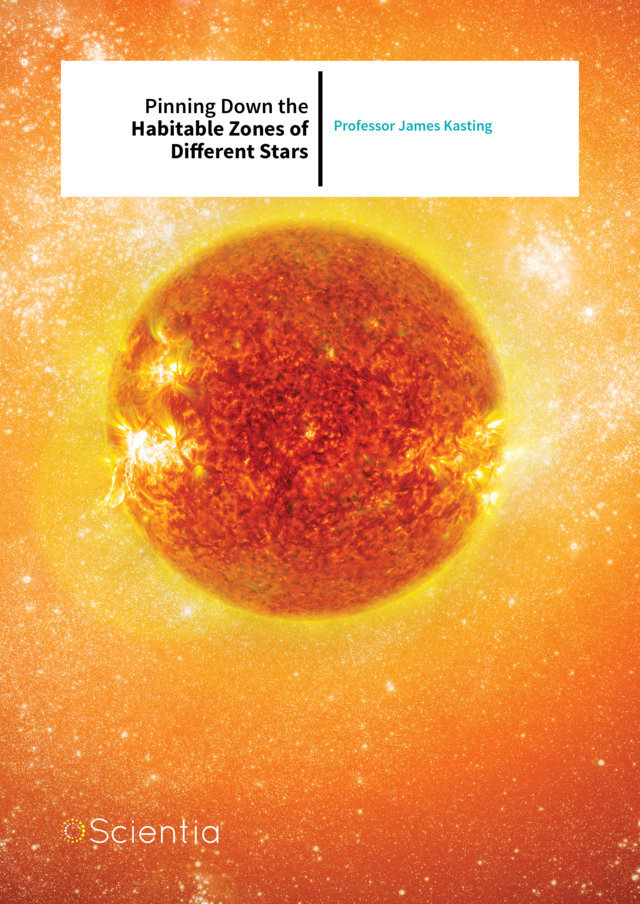Professor Jim Kasting – Pinning Down the Habitable Zones of Different Stars
One of life’s greatest mysteries is whether or not we are alone in the Universe. One way to find planets that could support life is by working out whether they lie in the ‘habitable zone’ of their parent star – a distance at which liquid water might exist on the surface. Professor Jim Kasting at Penn State University has been studying stars and the boundaries of their habitable zones for decades. More recently, he has been looking into how these boundaries can change with a phenomenon called climate limit cycling, which might occur on certain planets.
The Habitable Zone
Finding extra-terrestrial planets that may be able to support life is one of the biggest goals in astronomy. Since life as we know it relies on water to survive, one of the requirements for finding potentially habitable worlds is that liquid water must be able to exist on the planets’ surface. Life could exist on planets with subsurface water, as well, but it would be difficult to detect remotely, and so is of less interest to astronomers.
A planet too close to its star would be too hot, so any liquid water would evaporate, while a planet too far away would be too cold, and water would freeze. Astronomers have come up with the term ‘habitable zone’ to describe the area around a star that would be ‘just right’ for liquid water to exist. This region is also often called the ‘Goldilocks zone’ since, like the porridge in the well-known tale, it has to be just right.
Water is thought to be key in finding life, because all life as we know it relies on liquid water to exist. However, just because liquid water might be present on a planet does not mean humans could survive there, but astronomers consider the existence of water essential for Earth-like life-forms to survive.
Identifying terrestrial planets in the habitable zones of other stars is one of the primary goals of ongoing space surveys and proposed future space missions. NASA’s Kepler Space Telescope has so far detected over 3,000 planet candidates, about twelve of which are most likely rocky planets within the habitable zones of their host stars. But exactly how we know whether or not water can exist on a planet is a complicated question, with a rich history.
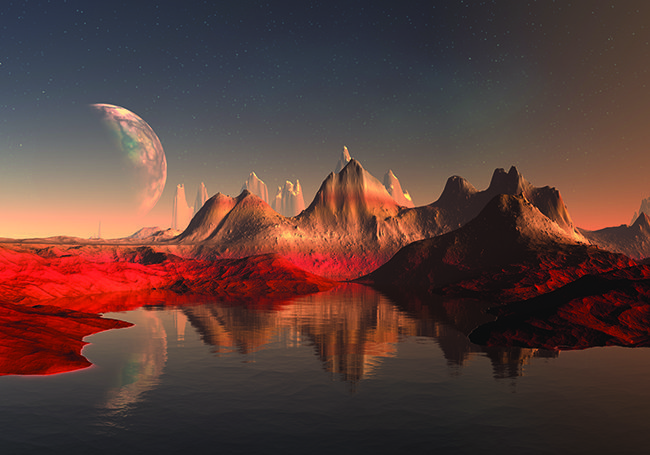
Over twenty years ago, in 1993, Professor Jim Kasting and his colleagues came up with a model to place restrictions on where the habitable zone could be for certain planets. ‘I derived estimates for the boundaries of the liquid water habitable zone using a 1-D climate model,’ explains Professor Kasting. The team came up with a set of inner and outer boundaries for habitable zones, as a function of the host star’s size and distance.
They defined the boundary’s inner edge as the point where water would be lost through photolysis – breaking up into hydrogen and oxygen – driven by light from the Sun. The outer edge was determined as the point where even a maximum amount of carbon dioxide – a greenhouse gas – fails to keep the surface of a planet above freezing temperatures. Their model showed that the habitable zone of our Solar System is located between 0.95 and 1.67 AU from the Sun (1 AU, or ‘astronomical unit’, refers to the average distance between Earth and the Sun – about 150 million kilometres!). This model was used in most calculations for a long time, without being updated.
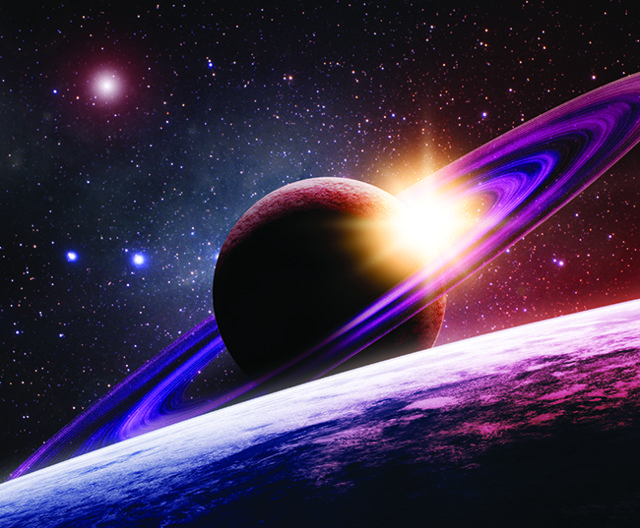
Twenty years later, Professor Kasting updated the model with new estimates. The calculations were done by a team of researchers, including his then postdoc Ravi Kopparapu and graduate student Ramses Ramirez. The updated paper, published in 2013, included more accurate calculations for factors such as the amount of energy that water vapour and carbon dioxide absorb. It also included the effect of light scattering by water vapour. ‘That moved the inner edge out from 0.95 AU to almost 1.00 AU, that is, close to Earth’s orbit,’ he says.
The problem here, was that having a boundary so close to Earth meant that we live on the edge of being non-existent. But this was based on a one-dimensional model, and could be further improved. ‘Fortunately, a French group came along and re-did the inner edge calculation using a 3-D climate model,’ Professor Kasting explains. ‘That moved the inner edge back to 0.95 AU, where it had been previously.’ The study, published in Nature in 2013, was carried out by Jeremy Leconte and colleagues from Laboratoire de Meteorologie Dynamique in Paris and the University of Chicago.
The three-dimensional model solved many issues. Before then, the habitable zone had mostly been studied using one-dimensional atmospheric models. As a consequence, the mechanism relied on the assumption that the troposphere is saturated in water vapour, and did not account for differences in cloud distribution. 3-D climate models are also needed to study planets around red dwarf (or ‘M’) stars. Because these stars are so dim, any potentially habitable planet must orbit quite close to the star; thus, it could become tidally locked, only showing one face to the star, as the Moon does to the Earth. 1-D models do not do a good job in this situation.
However, despite these improvements, there were still some effects that were yet to be taken into account. This would again move the goal posts of habitable zones.
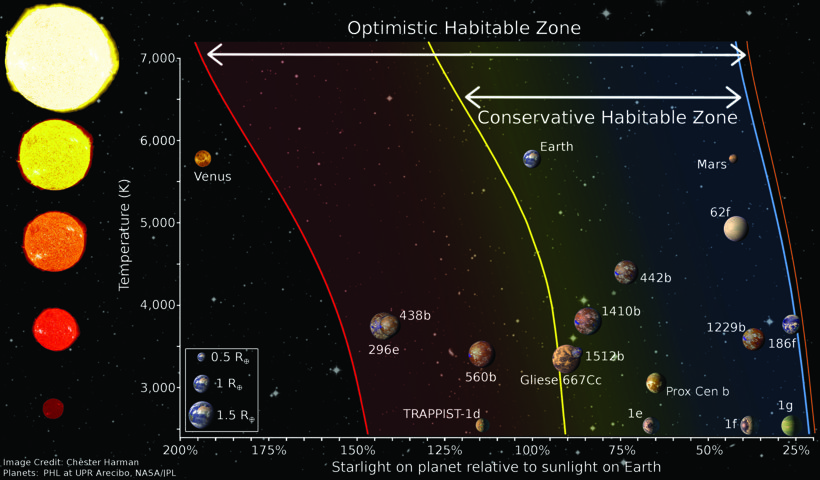
Climate Limit Cycling
Climate limit cycling happens when a planet undergoes alternating warm and globally glaciated periods, rather than having stable warm climates. ‘An astronomer at University of Toronto showed that some planets near the outer edge of the habitable zone might experience climate limit cycling,’ Professor Kasting tells Scientia. The astronomer was Kristen Menou, who published a paper in the journal Earth and Planetary Science Letters, outlining how climate limit cycling could affect a planet’s habitable zone. He explained how Earth-like planets receiving less sunlight than our Earth may no longer possess a stable warm climate, but instead repeatedly cycle between unstable glaciated and de-glaciated climatic states.
At temperatures above freezing, rocks can be weathered (dissolved), and they weather faster at higher temperatures. Carbon dioxide plays a role in this weathering, and is taken up during the process. This intake reduces the concentration of carbon dioxide in the atmosphere, and due to the resulting reduction in the greenhouse effect, the climate cools, ultimately leading to freezing conditions. On a frozen planet where no weathering takes place, carbon dioxide builds up in the atmosphere from the continued release of gas from volcanoes. This warms up the planet until liquid water can exist on the surface, and weathering starts to take place once again. This cycle could have implications for the search for life on exoplanets in the habitable zone of nearby stars.
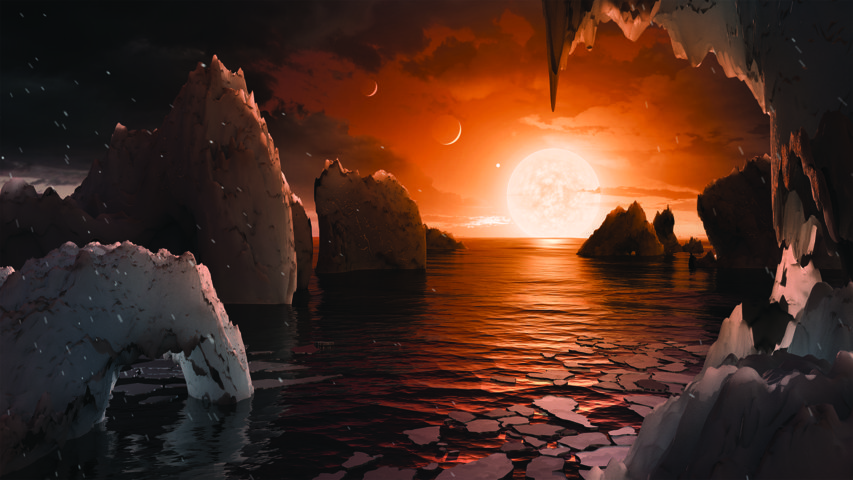
CREDIT: NASA/JPL-Caltech
Following the publication of this paper, Professor Kasting and colleagues took another look at the impact climate cycling would have on habitable zones. ‘We repeated those calculations, correcting an error in the volcanic outgassing rate, and showed that this limit cycling activity was less prevalent than Menou had found,’ he explains.
Professor Kasting and his colleagues argued that an abiotic Earth would have a greater carbon dioxide concentration than today, because plants and other biota help to pump up the carbon dioxide concentration in soil. When they tuned their abiotic model accordingly, they found limit cycles could occur, but that previous calculations had overestimated their importance.
Their study found that Earth-like planets with volcanic outgassing rates similar to those of today can maintain stable climates across the entire range of the habitable zone, regardless of the type of star they orbit. The type of host star, along with weathering and volcanic activity, turned out to all be important factors in determining whether a planet would be prone to limit cycling. The team also identified the best kind of stars for planets to orbit, in terms of their chances at being habitable.
Planets around F-stars – those between 1 and 1.4 times the mass of the Sun – were found to be the most prone to limit cycling behaviour, as a result of their susceptibility to ice-albedo feedback. This means they are likely to experience punctuated episodes of warm conditions followed by extended glacial periods.
The team also found that planets orbiting late K and M stars, which tend to be quite a bit smaller than our Sun, avoid limit cycles because of reduced ice-albedo feedback. However, these planets may suffer from water loss during their formation. The team concluded that systems with the greatest potential for habitability are those around late G- and early K-type stars, which are between 0.8 and 1.2 the mass of our Sun
Early Mars
In 2014, Professor Kasting and his colleagues applied the concept of climate limit cycling to models of the early Solar System, and discovered that young Mars might have been affected by the same kind of changes. ‘This same type of limit cycling might apply to our own Solar System planet Mars during its early history,’ he explains. Climate-driven changes in the temperature of young Mars bring it into the habitable zone, meaning it could have once supported life.
We know from studying Mars that it once held vast amounts of liquid water. Marks on its surface suggest the presence of an ocean, with some theories suggesting that it covered a third of the planet. For example, orbiters as far back as 1976 discovered two possible ancient shorelines near the pole – named Arabia and Deuteronilus – each thousands of kilometres long. Evidence has also been found in the chemical properties of Mars’ soil and atmosphere. A 2016 study carried out by NASA suggested that the volume of Mars’ early ocean was at least 20 million cubic kilometres, which is more than Earth’s Arctic Ocean.
Young Mars, however, was slightly too far away from the Sun for liquid water, according to Professor Kasting. ‘Early Mars is slightly beyond the outer edge of the habitable zone, so we need H2, in addition to CO2 and H2O, to warm it up,’ he explains. In order for liquid water to remain on the surface, early Mars would have needed a denser atmosphere, along with a warmer climate.
Signatures of Life
In a 2014 paper published in the Proceedings of the National Academy of Sciences (PNAS) Professor Kasting and his colleagues provided a review of habitable zones and remote biosignatures – or signs of life. In this paper, they outlined habitable zone boundaries along with the criteria needed to detect life remotely, and predicted the frequency of Earth-like habitable planets orbiting M and K type stars.
The team found that the conditions needed for liquid water on a planet continue to divide researchers. ‘Exactly what conditions are needed to maintain liquid water remains a topic for debate,’ they wrote in the paper. As with early Mars, adding H2 to a planet’s atmosphere can warm the planet and move the outer edge of the habitable zone farther out. Conversely (and counter-intuitively), planets with less water than Earth might actually be habitable closer to their parent star because the climate feedback caused by water vapour would be weaker.
Professor Kasting and his colleagues also came up with new guidelines to help scientists building the next generation of space telescopes, based on the detection of biosignatures. These telescopes will use so-called ‘direct imaging’ to look at planets around all the nearby stars. Such a telescope would use a coronagraph or a starshade to block out the light from the star, while retaining the reflected light from the planets around it. Doing so will enable astronomers to perform detailed spectroscopy, that is, looking at the frequencies (or colours) of light that are absorbed by the planet’s atmosphere, which tell scientists what gases are present.
The most interesting compounds to look for are called biomarker gases: species that might indicate whether life is present on a planet. One obvious choice is molecular oxygen, O2, which makes up 21% of Earth’s atmosphere. Most of Earth’s O2 is produced by photosynthesis, and thus, is a direct by-product of life. But O2 can also be produced by some abiotic processes, for example, by photodissociation (splitting apart) of water vapour, followed by the escape of hydrogen to space. The key to identifying life is to simultaneously look for reduced gases such as methane, CH4, or nitrous oxide, N2O. These gases, which are also produced by organisms, react with O2 and should not be found if life is not also present.
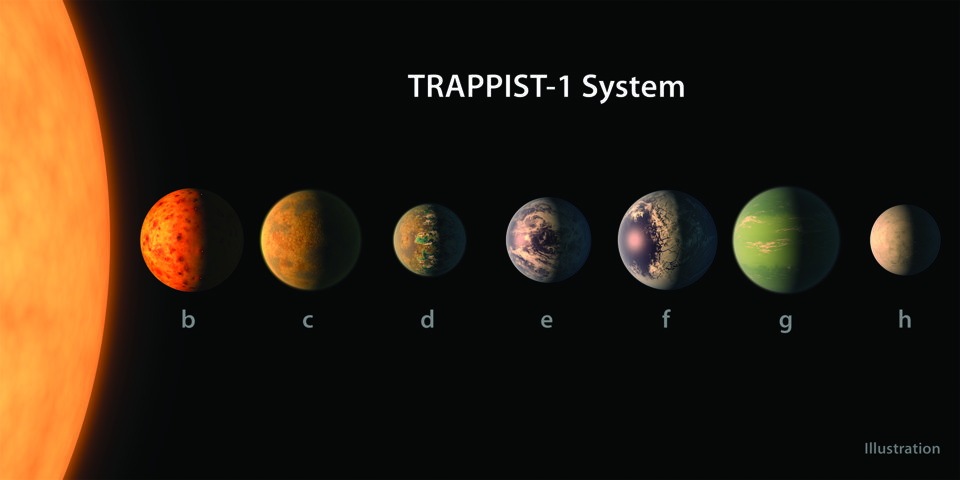
CREDIT: NASA/JPL-Caltech
Future Space Telescopes
Now that we know where to look and what to look for, the next generation of observing technology will allow us to search for extra-terrestrial life like never before. Professor Kasting says the future of space telescopes will provide the next step in studying planets in the habitable zone.
In particular, he points out NASA’s HabEx and LUVOIR projects – both being developed in the hopes of observing these planets within the next 20 years. These projects – the Habitable Exoplanet Imaging Mission (HabEx) and the Large UV/Optical/IR Surveyor (LUVOIR), are only concepts at the moment. They have both been selected for further study until 2020, when decisions will be made about whether or not to carry them out.
HabEx’s main goal is to directly image Earth-like exoplanets, and measure the composition of their atmospheres, for the first time. LUVOIR is a larger, general purpose space telescope that could also study a variety of exoplanets, including potentially habitable ones. Both of these projects would put Professor Kasting’s life work to the test in a practical way, by studying planets that lie within the habitable zones of their host stars.
Long before these concepts become reality, however, another mission will begin to apply our understanding of habitable zones. NASA’s James Webb Space Telescope (JWST) will start to search for life almost as soon as it is launched, which is planned for October next year.
The telescope is set to be the largest space telescope yet, and NASA hopes to use it to study everything from nearby stars to the most distant visible Universe. This will, of course, include looking at potentially habitable planets. Unlike HabEx and LUVOIR, JWST will only be able to look at planets that transit (pass in front of) their parent star. Most planets should not do this because their orbits are not aligned with our line of sight from Earth. But we already know of a few potentially habitable planets that do transit their star and that are not too far away. Three of the planets orbiting the M star TRAPPIST-1, 40 light years away, fall into this category. Thus, if we are lucky, we could detect signs of life on other planets as early as next year.
Meet the researcher

Professor James Kasting
Department of Geosciences
Penn State University
Pennsylvania
USA
Since 1994, Professor Jim Kasting has been a Professor of Geosciences and Meteorology at Penn State University, where he has been an Evan Pugh University Professor since 2012. After obtaining his AB in Chemistry and Physics at Harvard University in 1975, Professor Kasting went on to receive a PhD in Atmospheric Science at the University of Michigan in 1979. From 1979–1981, he worked for the National Center for Atmospheric Research. Then, between 1981 and 1988, he was first a postdoc, then a research scientist at NASA’s Ames Research Center, in the Space Science Division. In 1988, he became an Associate Professor at Penn State, before becoming Professor in 1994. Between 2003 and 2004, he was a visiting professor at NASA’s Jet Propulsion Laboratory and in 2006, he also spent time at Laboratoire des Sciences du Climat et de l’Environment in Gif-sur-Yvette, France.
CONTACT
T: (+1) 814 865 3207
E: jfk4@psu.edu
W: http://www3.geosc.psu.edu/~jfk4/PersonalPage/Kasting.htm
KEY COLLABORATORS
Ravi Kopparapu, NASA Goddard Space Flight Center
Jacob Haqq-Misra, Blue Marble Space Institute of Science
Shawn Domagal-Goldman, NASA Goddard Space Flight Center
David Catling, University of Washington
FUNDING
NASA
REFERENCES
JF Kasting, DP Whitmire, RT Reynolds, Habitble Zones Around Main Sequence Stars, ICARUS, 1993.
RK Kopparapu, et al., Habitable Zones Around Main-Sequence Stars: New Estimates, The Astrophysical Journal, 2013, 765, 131.
JF Kasting, et al., Remote life-detection criteria, habitable zone boundaries, and the frequency of Earth-like planets around M and late K stars, PNAS, 2014, 111, 35.
K Menou, Climate stability of habitable Earth-like planets, Earth and Planetary Science Letters 2015, 429, 20.
J Haqq-Misra, RK Kopparapu, NE Batalha, CE Harman, JF Kasting, Limit cycles can reduce the width of the habitable zone, The Astrophysical Journal, 2016, 827, 120.
NE Batalha, RK Kopparapu, J Haqq-Misra, JF Kasting, Climate cycling on early Mars caused by the carbonate–silicate cycle, Earth and Planetary Science Letters, 2016, 455, 7.


